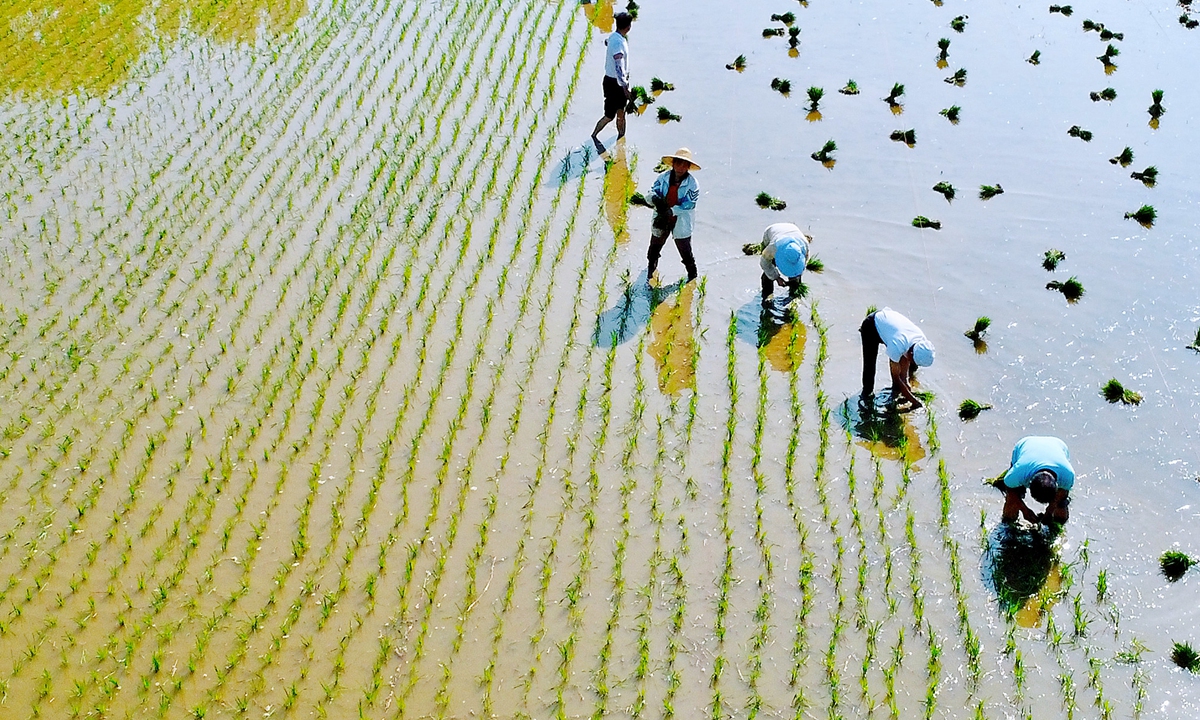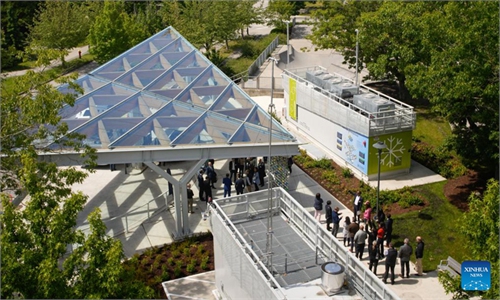ARTS / CULTURE & LEISURE
Xiazhi, Summer Solstice, when yang energy enters peak period

Villagers in Changgang village, Nantong, East China's Jiangsu Province transplant rice seedlings into paddies on June 18, 2024, as the summer solstice approaches. Photo: VCG
The 10th of China's 24 solar terms, Xiazhi, or the Summer Solstice, falls on Friday. The longest day and shortest night of the year in the Northern Hemisphere, Xiazhi is also when the sun reaches its highest point in the sky. After Xiazhi, the days begin to shorten and the nights gradually become longer.
When the sun moves to a 90 degree ecliptic longitude, it is the Summer Solstice. According to the Collective Interpretation of the Seventy-two Phenological Terms, compiled by Yuan Dynasty scholar Wu Cheng, ancient Chinese divided the Summer Solstice period into three pentads. The first is when the antlers of deer will begin to fall. The second brings the frequent singing of cicadas. During the third, Chinese medicinal herb banxia (Pinellia ternata) thrives. These phenomena are strongly related to the hot and humid climate during Xiazhi.
At this time, the plants grow lush under the blazing sun and polar days occur in areas north of the Arctic Circle.
In Chinese folklore, the 15 days after the Summer Solstice are divided into three phases. The first phase lasts three days, the middle, five days and the last phase is seven days. During this period, most parts of China see high temperatures, sufficient sunshine and crops grow fast. The precipitation at this time has a significant impact on agricultural yield. There is a Chinese saying, "Summer Solstice raindrops are as precious as gold."
The Summer Solstice was once an important festival in ancient China. The occasion was celebrated as early as the Han Dynasty (206BC-AD220). At that time, the traditional festivals such as the Mid-Autumn Festival and the Double Nine Festival were not as important as they are now.
By the Ming Dynasty (1368-1644), people took a day off to observe the Summer Solstice. In history records, the Song Dynasty (960-1279) granted officials a three-day holiday during the Summer Solstice period.
According to a book from the Northern Song Dynasty (960-1127), during the celebration of the Summer Solstice, women gifted each other colorful hand fans and sachets. The hand fans helped them stay cool while the fragrant sachets kept mosquitoes away and acted as a sort of perfume.
After the summer solstice, wealthy families also used ice collected during winter to cool off. In some museums, we can see ancient ice storage equipment made from wood and bronze. People used large cubes of ice as cups to hold drinks, melons and other fruit during summer time.
During the hot summer, without air conditioners, ancient people traveled to cooler areas in North China. While in South China, small pavilions were built with water around them, to create somewhere cool to spend one's leisure time.
A common custom in many places in China was to eat noodles on the day of the Summer Solstice. The popular saying goes, "On Winter Solstice people eat dumplings, for Summer Solstice noodles are served."
At this time, newly harvested wheat appears in markets, so eating noodles made from this wheat represents tasting something new.
In South China's Guangdong Province, there is the proverb, "Eat a lychee on the Summer Solstice and no harm will come all year long."
During this time, lychees hit the market. Their sweet and juicy taste was so impressive that many Chinese poets couldn't help but mention them in their works.
To deal with the heat and stay cool, people need to avoid the scorching sun, eat "heat-clearing" foods such as water melons, bitter gourd and bitter chrysanthemum, which can increase their appetites.
The Summer Solstice is the most vigorous time of the year, when the body's yang energy also enters the peak period. This means people are relatively on edge and easily irritated. This is also identified as "summer affective disorder syndrome" in psychology.
To stay calm, people are advised to adjust their schedules, have a nap after lunch, reduce outdoor activities and drink less wine and strong tea. Mung bean soup, green leafy vegetables, melons and other fruit are all good choices for diet in summer time.
During the Summer Solstice, farmers are still busy in the fields. Around this time, the areas where early rice is planted enter the heading and flowering period, and sufficient water is needed in the field to ensure heading, grain filling and fruiting. In southern areas where fruit is grown, adequate irrigation is of the upmost importance.


